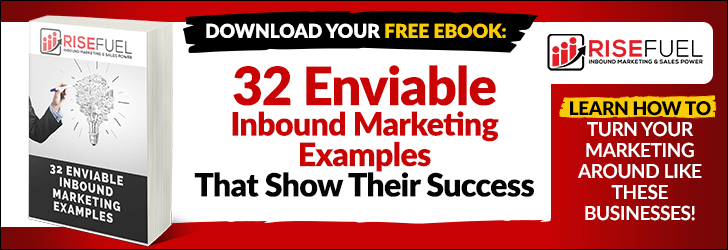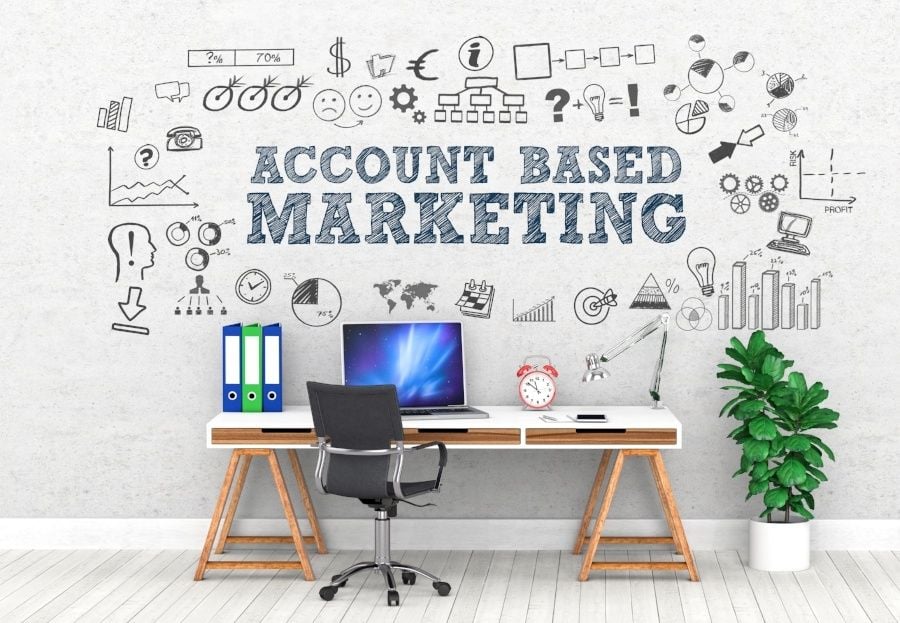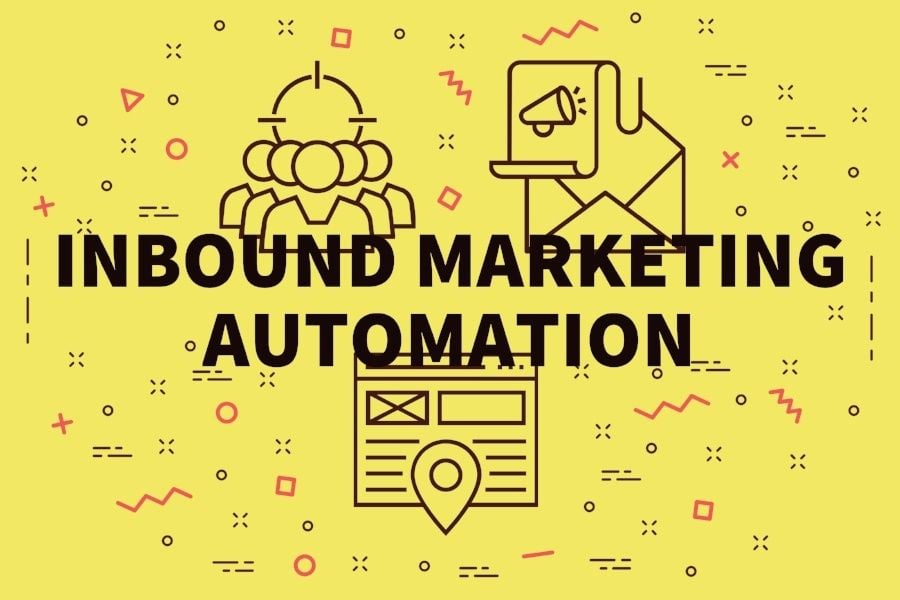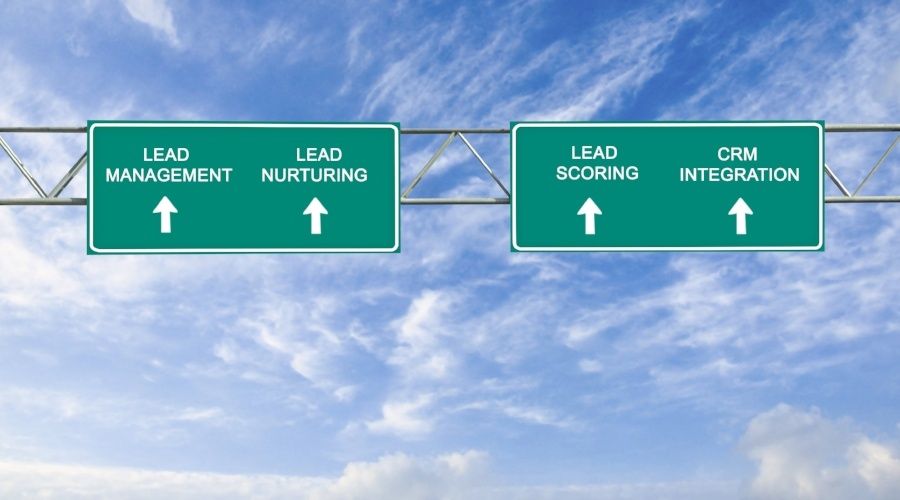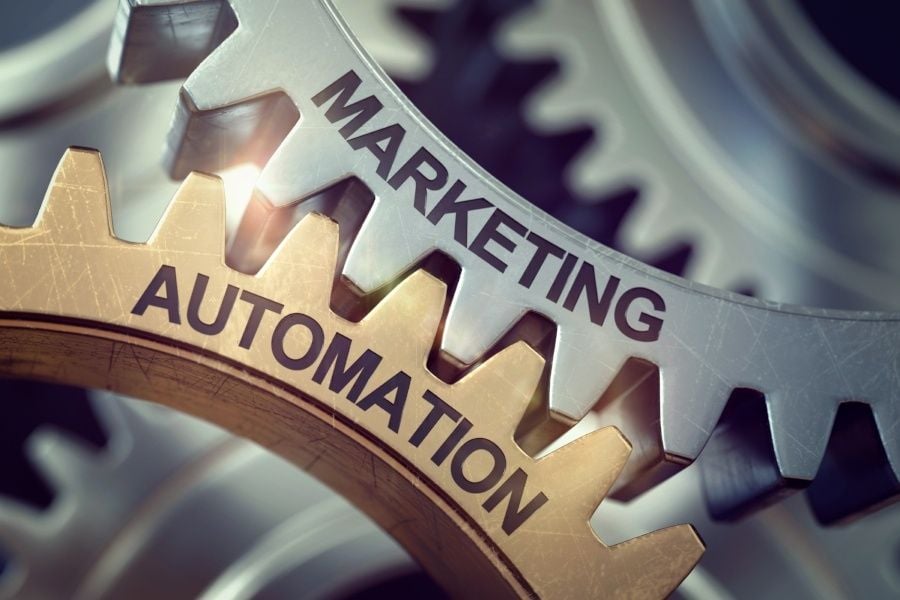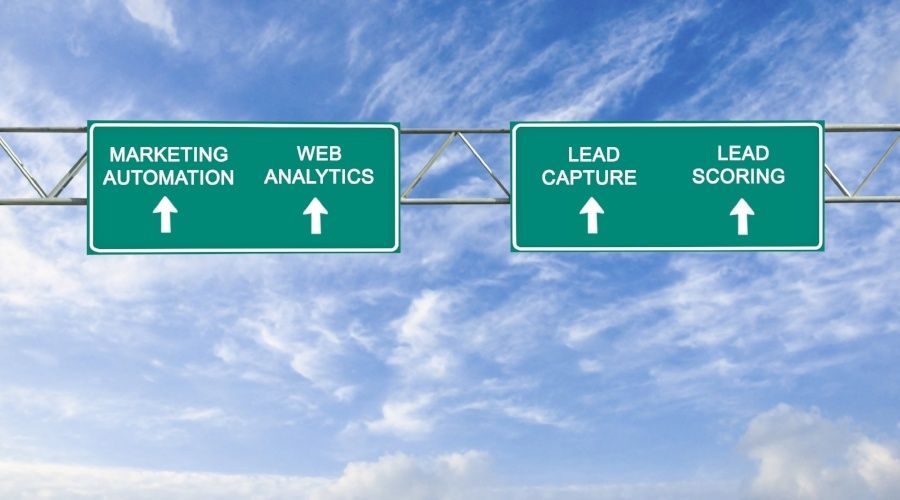
Customer expectations are changing rapidly and technology companies – from IT firms and MSPs (Managed Services Providers) to SaaS – need to evolve their marketing approach to stay relevant and competitive.
The biggest challenge is that most products and services in the industry are no longer the major differentiator.
They’re increasingly perceived as “commodities” – a slightly better price or a marginally better product is often not enough to distinguish a vendor from its competitors.
Also, technology products and services are moving from one-time installations or consultations to long-term engagements.
The need for ongoing enhancements and the shift toward subscription models mean customer relationships are paramount in generating sustainable profits.
Not to mention, the cost of acquiring a new customer is typically higher than that for retaining one. A high churn rate is one of the main reasons why technology companies fail to get off the ground.
Today’s customers demand more than just “products” or “services.” They don’t want to be “sold.” They want to do business with vendors with whom they have a relationship.
They demand an end-to-end experience that starts before they talk to the sales department and continues after they’ve made a purchase.
In fact, it’s predicted that by 2020, customer experience will overtake price and product as the key brand differentiator.
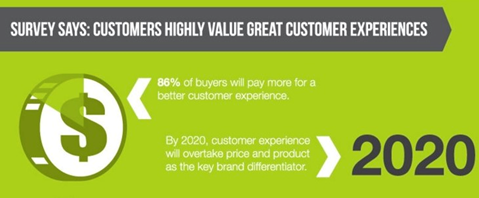
The need to deliver a buyer-centric experience requires companies to change how they communicate with customers to build trust and meaningful relationships.
A new way of engaging with customers is emerging, and it’s replacing the outbound techniques used traditionally:
Why Traditional Outbound Marketing Is Coming Up Short
In the past, technology companies rely on traditional outbound marketing to reach prospects. Although the method can reach a large number of people, the nature of the interaction isn’t conducive to building trust that leads to conversion.
Here are some of the shortcomings of outbound marketing and what you need to be doing instead:
Inability To Target And Optimize Marketing Budget
When you use mass media to promote your company, you’re paying to reach as many eyeballs as possible and then hope for the best.
It isn’t a cost-efficient form of marketing for technology companies because of the specific nature of the products or services.
Nor is it possible to track your marketing dollars all the way to conversion to determine what works and what doesn’t.
Instead, you need a marketing methodology that allows you to target specific customer segments and track your ad dollars so you can improve your ROI.
Interruption Marketing Erodes Trust
Mass media advertising and cold calling are interruptions that are particularly unpopular among the younger generations who are used to ad-free radio subscriptions, skipping TV commercials, using spam filters, and screening calls with caller ID.
Not only will you be unable to get the response you want, but you may also even negatively impact your brand image.
On the other hand, when you implement “permission marketing,” you’re communicating with prospects that have “raised their hands” to learn more about your offerings.
It generates high-quality leads that will increase the ROI of your sales and marketing efforts.
Sale Pitches Are Received With Skepticism
Customers are skeptical of sales pitches, which are one-way communication with the singular purpose of closing a deal.
Sales pitches are “company-focused” and often perceived as biased.
Instead, people want to be empowered to make their own choices by searching for and consuming content that allows them to educate themselves so they can make the right decisions.
Selecting a technology provider can be a challenging and even confusing process. By sharing relevant and valuable customer-centric content, you can position your company as a trusted ally to build trust and reduce client churn.
Limited Touchpoints Reduce Opportunities
Outbound marketing offers very limited time or space to deliver your message. If a prospect doesn’t see the ad in the right place at the right time, the opportunity is often lost.
In this new era of marketing, you need a myriad of customer touchpoints that gradually engage with, and nurture leads to deliver the right message that corresponds to the specific stages in your prospects’ decision-making process.
These touchpoints allow you to build the trust and relationship required for conversion and give you multiple opportunities to present your products and services non-intrusively.
Lack Of Engagement Leads To Slow Response Time
Most outbound marketing tactics don’t incorporate a two-way conversation with your customers that allows you to track responses in real-time. It limits your ability to react in a timely manner to optimize your results.
Instead, adopt a marketing methodology that enables you to track interactions with and response from your customers in real-time, so you can fine-tune and adjust your messaging to maximize your marketing ROI.
Inbound: A New Era Of Customer Engagement
To meet the shifting customer expectations in the technology industry, companies need to switch to a customer-centric marketing approach that focuses on building relationships that not only leads to conversion but also improves customer retention.
The inbound marketing methodology, with its emphasis on engaging customers throughout the entire buying cycle, is particularly suited for the technology industry.
Its focus on using relevant and valuable content to nurture leads, educate prospects, and support customers gives you the opportunity to connect with buyers through multiple touchpoints, so the right messages are delivered in the right place at the right time to optimize results:\
- Build your website’s “SEO juice” and get found on relevant online searches.
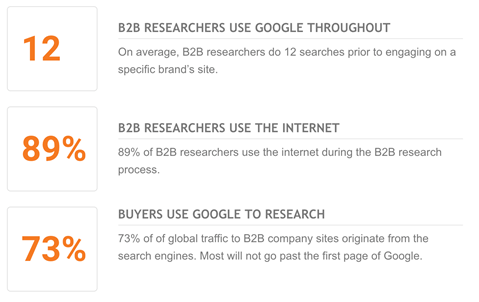
Image Source - Position your brand as a thought leader and trusted authority to build trust.
- Show up in the right place at the right time with the right message to stay top of mind – e.g., on search results or social media feeds.
- Capture high-quality leads by getting prospects to “self-identify” their roles, needs, and interest levels.
- Optimize account-based marketing (ABM), which is very effective for B2B selling within the tech industry.

Image Source- Nurture leads by delivering targeted content that engages and educates prospects, moving them along the buyer’s journey toward conversion.
- Identify “hot” leads that are close to making a purchasing decision, so you can focus your sales team’s resources on closing the deal.
- Build relationships post-purchase to reduce churn rate, improve customer loyalty, and increase retention.
- Turn your customers into your sales force through referral (word-of-mouth) marketing by cultivating advocacy.
- Leverage customer data and tracking technologies to increase ROI of your marketing dollars.
Not to mention, inbound leads cost 61% less than outbound leads, and the methodology is ideal for companies aiming to increase long-term ROI.
Technology companies have unique needs.
To get the most out of your marketing efforts, you need to tailor the inbound methodology to the specific customer lifecycle of your business:
What’s Inbound Marketing?
According to Hubspot, an industry authority, inbound marketing focuses on attracting customers through relevant and helpful content, which adds value at every stage of the buying journey.
The framework is built on customer lifecycle, and the strategies are designed to move prospects along the purchasing path.
With inbound marketing, prospects find your business through channels like blogs, search engines, and social media.
By publishing content that addresses the problems and needs of your ideal customers, you attract high-quality leads while building trust and credibility for your business – which will lead to better conversion and customer retention.
Also, inbound marketing is measurable. With the right technologies, you can track every marketing dollar to help fine-tune your tactics so you can focus on marketing activities that deliver the highest ROI.
The Inbound Marketing Framework
The four stages of inbound marketing – attract, convert, close, and delight – is a customer-centric framework that helps orchestrate multiple customer touchpoints and organize your content production and promotion efforts.
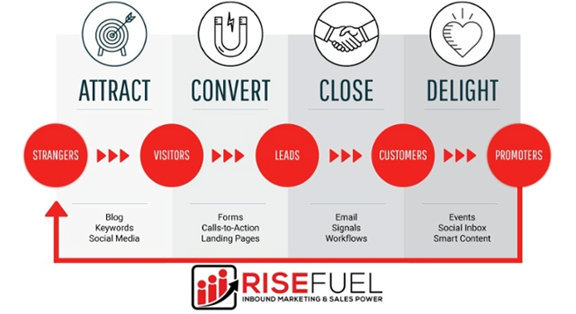
1. Attract
The goal of this stage is to get in front of high-quality leads looking for a specific solution that your company’s products or services can provide.
These prospects are most likely doing some research online and seeking educational content to help them understand their problems and make an informed decision.
The inbound methodology is designed to capture your prospects at, or before, this stage by publishing online content that drives traffic to your website (e.g., with SEO), builds awareness, and positions your company as an industry leader.
Besides optimizing for search engines, you can also get exposure to a new audience by guest posting on authority websites or co-hosting webinars with companies that offer complementary products or services.
Also, social media is a great way to promote your content thanks to the ability to target a specific audience on these platforms.
2. Convert
Once you start driving traffic to your website, you need to convert visitors into leads by collecting their contact information so you can continue the conversation, build trust, and follow up.
You can offer a piece of valuable information (a lead magnet) in exchange for your prospects’ information.
This lead magnet can be a downloadable digital file with educational content that solves your audience’s challenges. Or it can be a webinar, a format that has a high perceived value and is popular among B2B marketers in the technology sector.
Alternatively, you can give prospects a taste of what your product or services can achieve for them.
For instance, many SaaS companies entice website visitors to sign up for a free trial, while IT and MSP companies may offer a complimentary evaluation to help prospects identify their needs and become educated about their challenges.
Besides email and name, you can use this opportunity to gather other pertinent information during the sign-up process to segment your list. E.g., particular products the prospects are interested in or the roles, titles, or company size of B2B customers.
Once you have collected prospects’ information, you can continue to nurture the relationships by providing value through content while educating prospects about your products.
3. Close
Sitting on a large email list won’t make you any money if subscribers or free-trial users aren’t turning into paying customers.
This stage focuses on nurturing leads with the objective of turning subscribers into customers or converting users from a free plan to a paid plan.
A CRM (customer relationship management) system helps you keep track of these relationships so you can follow up with the most relevant content and offers.
Such a centralized system allows for the transparency that your inbound marketing team and inbound sales team need to work in synch and deliver a seamless sales experience.
It allows you to leverage the power of personalization automation in email marketing, which has the potential to generate an ROI of 4300%.
With the ability to segment your list and leverage personalization technologies, you can deliver content and offers that are most relevant and valuable to the lifecycle stages of each prospect, taking them down the path to conversion.
SaaS companies, in particular, can track usage and send appropriate content triggered by users’ activities to encourage adoption and increase engagement.
A CRM system also allows you to collect and evaluate data and identify leads most likely to convert with a technique called “lead scoring” so you can focus resources in following up with leads that are most likely to convert.
4. Delight
Inbound marketing, with its emphasis on cultivating customer relationships and advocacy, is well suited to help you increase customer loyalty after the initial transaction – e.g., getting customers to stay on a subscription plan, upgrade to a higher-tier plan, or sign up for ongoing maintenance service after initial installation.
At this stage, you can offer exclusive content that helps your customers get the most out of your products, have industry experts share their knowledge in customer-only webinars, or invite customers to conferences and events.
Delighting customers is critical for technology companies that generate a substantial portion of their revenues from recurring customers or subscribers.
Long-term customers not only have a higher customer lifetime value, but they’re also more likely to purchase higher-priced products or services.
When you’re able to retain loyal customers, your churn rate will decrease, and you don’t have to invest as much in customer acquisition to sustain a revenue goal.
The Essential Components Of Effective Inbound Marketing
There are many different strategies, tools, and approaches as inbound marketing continues to expand as a discipline.
The exact strategies and tactics you use may differ based on your target market, business objectives, and budget.
However, there are some basic components you need to know if you want to get the most out of your marketing dollars:
Business Objectives
You need to first set specific and measurable goals to help select the most suitable strategies and tactics for your marketing.
Establish key performance metrics (KPIs) to measure the effectiveness of your efforts so you can focus on the activities that’ll move the needle for your business.
Buyer Personas
A buyer persona is a “profile” of your ideal customer. Besides demographic information, it should address your ideal customers’ psychology, desires, values, challenges, habits, and preferences.
IT firms or MSP that sell mostly B2B are likely to be dealing with multiple stakeholders during the sales process. They have different priorities, and you need to create a persona for each to help understand what they’re looking for at each stage of the process.
Understanding your target audiences allows you to focus resources on reaching high-quality leads by showing up in the right place at the right time with the right message.
Customer Journey (Lifecycle Stages)
A customer journey is constructed from the customers’ perspective to map out their experiences at each stage of interacting with your business.
It helps you understand what prospects need to know and how to position your content so they’ll progress through the purchasing path.
For example, a prospect at the “close” stage may find information specific to your products most helpful. However, such content is quite irrelevant to an audience that is still in the “attract” stage.
SaaS companies, which often depend on user adoption for conversion and retention, should also address the obstacles that prevent users from continuing to engage with the software or utilizing new features.
Trigger emails with specific content can be created to provide support and help re-engage lagged users.
Content Map
A content map sums up your buyer personas, their customer journey, the kind of content that will appeal to them at each stage, and the channels through which prospects and customers interact with your business.
It’s the roadmap to producing relevant and valuable content, which will help you attract and convert ideal customers by staying focused on your content production and promotion efforts.
You can also use it to help determine the format of your content. You may explore using visual content (e.g., videos or infographics) for more technical topics to bring the information to life.
A content map also allows you to communicate your content strategy so you can effectively delegate or outsource these tasks.
Content Calendar
A content calendar gives you the structure to coordinate content production, implementation, and promotion so you can manage your content marketing, which is an essential component of inbound marketing.
For technology and software companies, it’s important to keep in mind that the content needs to speak to your audience’s challenges at each stage instead of focusing on the features and functions of your products.
This document should map out at least 3 – 6 months worth of content, so your marketing team can line up everything required to utilize and promote a piece of content effectively (e.g., email marketing, social media marketing, influencer marketing, etc.)
Measurement Of Success
When you have the right technologies in place, it’s easy to gather metrics and track the success of your campaigns against the KPIs established in your business objectives.
Review your data periodically with your marketing team to see what’s working and what isn’t. Run A/B tests to help fine-tune your tactics then make adjustments to optimize your marketing budget.
Harness the Power Of Inbound Marketing For Long-Term Success
Inbound marketing is a very powerful marketing methodology for technology companies. The content you create becomes marketing assets that will help you attract and retain customers for years to come.
However, defining a sound strategy, setting up the right technologies, and coordinating the many moving parts can be overwhelming – even if you have an in-house marketing team.
Here at RiseFuel, we have spent 12 years perfecting inbound marketing for technology companies.
From increasing brand awareness and driving high-quality traffic to nurture leads and increasing customer lifetime value, we take the best of inbound marketing and turn it into strategies that technology companies can use to acquire and retain more customers.
Learn more about our Technology Marketing Service or give us a call at (704)-246-4521 to see how we can help.



